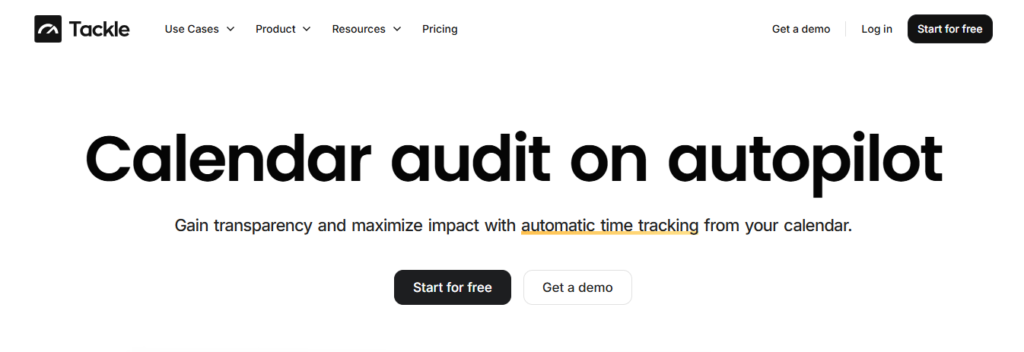Imagine hiring a manager who can talk about vision but freezes when you ask about conflict or delegation. Consider the best free habit tracker app, which reveals patterns over time. Similarly, the right leadership interview questions enable you to track a candidate’s habits in decision making, delegation, communication, accountability, and strategic thinking. This guide lays out leadership interview questions to ask, what to listen for, sample behavioral and situational prompts, follow-up probes, and common red flags.
To simplify this process, Tackle’s automatic time tracking software frees you from admin tasks. It provides clear evidence of how leaders spend their time, allowing you to focus on asking the right leadership interview questions and listening for the signals that matter.
What Makes a Good Leadership Interview Question?

A strong leadership interview question uncovers how a candidate thinks and acts, not just what they list on a resume. It reveals pattern and process, such as how they prioritize work, influence others, handle conflict, and take responsibility for results. Ask for concrete actions, and you will get evidence of management style, stakeholder handling, and performance under pressure.
Probe Problem Solving and Critical Thinking
Ask for examples where the candidate faced complexity or trade-offs. Good prompts: Tell me about a time you solved a problem that had no obvious answer. Look for structured thinking, use of data or judgment, trade-off analysis, and how they balanced short-term fixes with long-term impact.
Assess Communication and Influence
Leaders need to explain the strategy and gain buy-in. Watch for clarity, audience awareness, and the use of examples or metrics to align team members.
Test Decision Making and Accountability
Good questions force a candidate to show their decision process. Try: Describe a high-stakes decision you made with incomplete information. Strong answers include the source of information, trade-off rationale, and the steps taken after the decision to monitor outcomes.
Measure Adaptability and Resilience
Leaders must change course when conditions shift. Look for quick learning, precise adjustments to strategy, and actions taken to restore team confidence after setbacks.
Why Behavioral Questions Work
Behavioral leadership interview questions ask for real past events. They show consistent behavior over time and expose habits, such as how the candidate handles conflict, motivates people, or drives performance. Ask for context, actions, and measurable outcomes and expect concrete evidence of leadership competencies.
Why Situational Questions Work
Situational questions place the candidate in a realistic problem today. Use scenarios tied to the role, for example, a sudden budget cut or a key team member leaving. Ask how they would act step by step. Their answer reveals problem-solving, prioritization, stakeholder management, and the ability to create short-term plans that support long-term goals.
Example Behavioral Leadership Interview Questions
- Tell me about a time you turned around a team that missed goals. What first steps did you take, and what metrics changed?
- Give an example of a conflict you managed between two direct reports. How did you diagnose the root cause, and what was the result?
- Describe a time you coached someone who was not meeting expectations. What approach did you take, and how did their performance change?
- Tell me about a time you led a change that faced resistance. How did you measure adoption and adjust your approach?
- Share an example of balancing competing priorities across teams. How did you choose where to focus resources, and who did you involve?
Example Situational Leadership Interview Questions
- You have a project behind schedule and several teams blaming each other. How would you regain momentum this week?
- A key customer threatens to leave unless you cut features. What trade-offs would you consider and how would you decide?
- One of your managers is making decisions without consulting her team, which is causing morale to drop. What steps would you take immediately and over the next quarter?
- You face a sudden hiring freeze while growth targets remain. How would you meet targets without new hires?
Follow Up and Probing That Reveal Depth
Follow up with targeted prompts that force specifics. Ask:
- What did you say?
- Who did you call?
- What document did you create?
- What metric moved and by how much?
Use why questions to uncover values and priorities. Ask how they handled dissent and what they learned from the outcome to see growth and self-awareness.
Red Flags in Candidate Responses
Vague outcomes, no metrics, shifting blame, and reliance on jargon signal weak leadership. Watch for overly heroic solo narratives. If someone cannot name stakeholders or cannot explain the trade-offs they made, probe deeper. Pay attention when they avoid responsibility or fail to follow up.
Scoring and Competency-Based Evaluation
Define competencies before the interview, such as strategic thinking, communication, coaching, and execution. Use a simple rating scale with anchor examples for each level. Score on evidence, not impression. Capture direct quotes and measurable outcomes to support hiring decisions.
Quick Interview Techniques to Improve Hiring
Use structured questions across candidates to compare apples to apples. Include a mix of behavioral and situational prompts. Record or take verbatim notes of answers to aid calibration later. Ask the identical follow-up probes so you test depth and consistency.
12 Core Leadership Interview Questions (With What to Listen For)

1. Leading Through Change: Ask for a Clear Example of Shifting Direction
What to listen for: Resilience, clarity of communication, and ability to motivate others. Look for a clear example of how they aligned their team around a new direction.
Strong leaders tell a concise story of the change, the stakes, the steps they took, and the outcome. Listen for clarity about why the change was needed, how the leader communicated goals and trade-offs, and how they brought skeptics on board.
Watch for signs of sustained follow-through, such as checkpoints, adjusted processes, or morale tracking. Red flags include vague timelines, blaming others, or failing to describe how team members adapted.
2. Handling Team Conflict: Test Emotional Intelligence and Mediation Skill
What to listen for: Emotional intelligence, mediation skills, and fairness. Strong answers show they address conflict quickly and constructively to maintain team cohesion.
A persuasive answer names the conflict, the leader s role, and the techniques used to restore trust. Good responses include neutral framing, private conversations, and structured agreements about behavior and deliverables.
Look for the use of active listening, reframing interests, and setting expectations rather than avoidance. Beware of answers that downplay employee feelings or that escalate with threats.
3. Decision Making With Limited Data: Expect Clear Reasoning Under Uncertainty
What to listen for: Decisiveness, risk assessment, and accountability. Look for a candidate who explains their reasoning process and takes ownership of the result.
Effective leaders describe trade-offs, assumptions, and contingency plans when they lack complete data. They identified the information they prioritized, their rapid hypothesis testing, and their acceptance of responsibility for the outcome.
Strong answers include how they communicated uncertainty to stakeholders and how they adjusted after new information arrived. Weak answers hedge, claim perfect foresight, or hide accountability.
4. Measuring Leadership Success: Focus Beyond Personal Metrics
What to listen for: Focus on team outcomes, growth of others, and organizational impact, not just personal metrics.
The best leaders define success in team performance, retention, capability growth, and alignment to strategy. Look for examples such as improved delivery rates, promotions within the team, or successful cross-functional initiatives tied to leadership actions.
Answers that only list personal KPIs reveal a narrow view. Ask for concrete metrics they tracked and how they used those numbers to change behavior.
5. Coaching and Developing Team Members: Seek Concrete Coaching Habits
What to listen for: Specific coaching strategies, evidence of mentorship, and commitment to employee growth and retention.
Look for regular one-on-ones, tailored development plans, and examples where coaching produced measurable improvement. Strong answers demonstrate an ability to identify learning gaps, assign challenging projects, and remove obstacles, enabling people to succeed.
Notice if the candidate references feedback loops and follow-up. Weak replies discuss generic praise without structure. Ask for an example where coaching changed someone s trajectory and what steps the leader took.
6. Motivating a Disengaged Employee: Check for Empathy and Personalization
What to listen for: Ability to identify root causes of disengagement, use empathy, and create personalised motivation strategies that lead to measurable improvement.
A solid story names the cause of disengagement, whether it was unclear goals, burnout, or a mismatch of skills, and describes a targeted intervention. Good tactics include resetting expectations, offering development opportunities, shifting responsibilities, or addressing workload.
Look for measurable change, such as restored output or improved engagement scores. Red flags include one-size-fits-all motivation or quick threats to replace the person.
7. Prioritising Competing Demands: Look for Systems, Not Panic
What to listen for: Time-management discipline, ability to assess impact, and willingness to delegate. The best answers show a systematic approach rather than reactive behaviour.
Strong candidates describe a framework for prioritisation, such as impact versus effort, stakeholder criticality, or deadlines tied to revenue. They explain how they reallocate resources, delegate, and say no to low-value work.
Practical examples illustrate trade-offs and the logic behind protecting strategic work. Watch for answers that equate busyness with progress or that lack delegation.
8. Influencing Without Authority: Look for Persuasion and Relationship Craft
What to listen for: Persuasion skills, relationship-building, and use of data or storytelling to gain buy-in.
The best answers reveal a sequence: understand the other party s goals, build credibility, present evidence, and create win-win options. Listen for examples where the leader used data, small tests, or champions to shift opinion. Weak responses focus on pressure or avoiding hard conversations.
9. Giving Tough Feedback: Expect Directness Paired With Care
What to listen for: Direct but empathetic communication, follow-up actions, and evidence that the feedback led to growth rather than resentment.
Strong candidates frame feedback against behavior and outcomes, set clear expectations, and schedule follow-up to measure improvement. They balance candor with a plan to support skill development.
Clues to effectiveness include improved performance, changed behavior, or a documented development plan. Warning signs include evasive language or stories that end with the employee leaving without remediation.
10. Fostering Diversity, Equity, and Inclusion: Demand Concrete Actions
What to listen for: Concrete actions (not just value statements) such as inclusive hiring practices, mentorship for underrepresented employees, and creating psychological safety.
Look for specific practices such as structured interviews, diverse candidate slates, sponsorship programs, and inclusive meeting norms. Effective leaders cite metrics they monitor, like representation in pipelines or promotion rates, and describe interventions they ran. Superficial answers focus solely on intention without considering measurement or process change.
11. Handling Team Failure: Gauge Accountability and Lessons Learned
What to listen for: Accountability, ability to learn from setbacks, and how they supported their team through failure while preventing repeat mistakes.
Good responses take team ownership, analyze root causes, and implement process or guardrail changes. They describe how they protected morale and used the failure as a learning moment through post-mortems or revised workflows. Red flags are blame shifting, hiding the failure, or repeating the same error.
12. Communicating Strategy and Vision: Connect the Big Picture to Daily Work
What to listen for: Clarity, consistency, and ability to connect the big picture to daily work so employees feel engaged and understand their role in achieving goals.
Effective leaders translate strategy into objectives, priorities, and clear ownership for tasks. They use multiple channels, repeat key messages, and tie individual goals to organisational outcomes. Look for examples of town halls, leader rounds, or visual road maps that helped the team act with context. Weak answers are high-level and leave teams guessing about next steps.
Try Tackle’s automatic time tracking software to capture and categorize your team’s work without manual entry. Start for free with one click and see clear insights from calendar activity.
Related Reading
- Happy Friday Meme
- How Many Work Weeks in a Year
- Friday Memes for Work
- How Many Weekend Days in a Year
- How Many Working Hours in a Month
5 Advanced Questions for Senior Leaders

1. Make Strategy Real: Turning Big Goals into Daily Work
What to listen for: Clear examples of cascading strategy into actionable objectives, setting measurable KPIs, and communicating priorities so that every team member understands how their work contributes to the bigger picture.
A strong leader maps the company strategy into concrete team objectives and measures. Look for specific mechanics:
- An OKR cascade or objectives linked to a strategic plan
- A set of KPIs tied to customer outcomes or revenue
- Cadence for review, such as weekly stand-ups and monthly scorecards
Request a specific example of a goal cascade and the key metrics that demonstrate progress.
Interview Questions on Goals and Priorities
Practical evidence includes a documented goal tree, dashboards that show leading indicators, role-level goals that tie to a top-line metric, and regular rituals that shift work toward priorities. Good answers name the tools used, how priorities were communicated, and how trade-offs were decided when capacity was limited.
Probing questions to use in an interview:
- Give me an example of a strategic objective you translated into teamwork.
- Which KPIs moved first and why?
- How did you handle a manager who ignored the new priorities?
Scoring Leadership Interview Responses
High-scoring responses cite timelines, numeric targets, stakeholder alignment, and a repeatable process. Red flags include vagueness, lack of measurable outcomes, or reliance on charisma over process.
Assessment criteria and scoring hints: Award the highest marks for examples that show measurable impact, cross-functional coordination, and explicit communication methods. Middle scores indicate an intent, albeit with partial metrics. Low scores show no link between team tasks and company strategy.
2. Shaping Culture: From Values to Habits
What to listen for: Evidence of intentional cultural shaping, whether through values rollouts, recognition programs, or restructuring, and the ability to measure the impact on engagement, retention, or performance.
Driving Measurable Culture Change
Culture changes when leaders act with intention and measure results. Seek stories that demonstrate the design and implementation of programs such as values-based hiring, structured recognition, manager training, or performance review changes that reinforce desired behaviors.
Strong examples include a baseline survey, interventions, and follow-up metrics such as engagement scores, voluntary attrition, or productivity gains.
- What did engagement look like?
- What did you change
- What moved as a result?
Listen to how they handled pushback and how they sustained momentum through rituals, onboarding, and leader modeling.
Culture Change Assessment
Probing questions:
- Describe the pilot you ran.
- How did you measure adoption?
- Who owned the effort long term?
Watch for responses that show measurement, governance, and a plan to embed behavior change through processes. Caution against anecdotes lacking proof and culture programs that are one-time and unsupported.
Evaluation guide: Strong answers name specific metrics and show causal links to policy or program changes. Weak answers center on slogans or vague statements about values.
3. Steady Hands in a Storm: Leading Through Crisis
What to listen for: Composure under pressure, data-driven decision making, and how they balanced short-term survival with long-term strategy. Look for a leader who can explain the lessons learned and how they applied them going forward.
Crisis leadership exposes gaps in planning and character. The best examples show rapid triage, transparent communication, scenario planning, and disciplined trade-offs. Expect specifics:
- The cash runway
- Measures taken to preserve core capabilities
- Stakeholder communications cadence
- Decisions on hiring, product roadmap, or cost reductions
Ask them to quantify the impact and to describe any contingency plans they put in place. Probe how they preserved trust with employees, customers, and the board while making hard choices. Look for evidence of learning, like asking what changes they make to governance, forecasting, or risk management after the crisis.
Crisis Leadership Evaluation
Interview prompts:
- Walk me through the first 72 hours and the first 90 days.
- What metrics did you watch daily, and which weekly?
- What mistakes did you make, and what changes did you keep?
Red flags include blame shifting, a lack of measurable outcomes, or no clear learning steps after the crisis.
Scoring guidance: Rate highly those who show calm decisions supported by data, swift communication, and a durable plan to recover and strengthen the business.
4. Choosing Bets: How Executives Prioritize Opportunities
What to listen for: Strategic thinking, ability to weigh ROI and risk, and collaboration with peers or the board. Strong answers will reference frameworks like OKRs, cost-benefit analysis, or portfolio management rather than gut instinct alone.
Executive Prioritization Frameworks
Executive prioritization should be systematic. Look for use of frameworks such as opportunity scoring, expected value analysis, portfolio balance across short-term and long-term bets, and stage gate reviews for pilots.
Strong leaders require business cases with metrics, risk assessments, and go/no-go criteria. They also align with capacity and talent constraints and surface dependencies across functions.
Ask candidates:
- How do they triage competing initiatives, and how do they involve peers and the board?
- What financial and operational metrics were required before committing?
- How did they run experiments to de-risk options?
Decision-Making & Prioritization
Probing questions:
- Show me a decision where you killed a pet project.
- What framework did you use and why?
- How do you balance innovation with cash management?
Watch for answers that pair quantitative decision tools with stakeholder management and clear escalation paths. Red flags are decisions justified primarily on charisma or short-term optics.
Scoring sheet tips: High ratings are given when candidates demonstrate repeatable prioritization methods, cross-functional governance, and a bias towards testing before scaling.
5. Growing Successors: Building a Leadership Pipeline
What to listen for: A proactive approach to succession planning, mentoring, and leadership pipeline development. This shows they are thinking beyond their tenure and building organisational resilience. Senior leaders must cultivate successors and a resilient bench. Expect concrete programs:
- An annual succession review
- Nine-box or readiness assessments
- Stretch assignments
- Mentoring and coaching
- External development options
Leadership Development Metrics
Strong leaders document readiness levels, set timelines for development, and tie promotions to clear milestones. Ask for examples of leaders they developed, the interventions used, and the outcomes.
- How did they decide when to promote versus when to hire externally?
- How did they reduce the time to fill critical roles?
Good answers include metrics such as internal promotion rates, time to readiness, and retention of high potentials.
Succession Planning Evaluation
Interview prompts:
- Describe a successor you prepared who later failed or succeeded.
- What did you change in your approach after that outcome?
- Which development tools did you use, and who owned them?
Red flags include ad hoc mentoring without measurement, no formal succession process, or an unwillingness to hand over power.
Assessment checklist: Prioritize candidates who demonstrate structured succession planning, measurable pipeline health, and a proven ability to develop leaders through hands-on experience and constructive feedback.
How to Evaluate Answers Objectively

Use a structured scoring rubric before you meet the candidate. Break the role into 6 to 10 core competencies tied to job outcomes, such as leadership style, strategic thinking, team management, decision making, conflict resolution, and stakeholder management.
For each competency, define behavioral anchors for scores 1 to 5 that describe observable evidence, not impressions. Ask the same core leadership interview questions to every finalist so you can compare apples to apples. Score answers immediately using the anchor language and capture the exact phrases or examples the candidate gave for later calibration.
Why This Matters: The Hiring Pressure
44 percent of HR teams say talent acquisition is their greatest struggle, and 48 percent report that attracting the right candidates has become harder recently. These numbers change how you prioritize objectivity and speed in selection so you avoid costly hiring mistakes.
Role Fit: Match the Job Needs to Real Experience
List must-have skills, nice-to-have skills, and the most critical business outcome for the role. For each candidate, mark how many core requirements they meet and where their experience maps to your company priorities.
Look for depth in areas that drive the role’s results, such as revenue growth, process improvement, or team development. Include behavioral evidence that shows past performance in those areas.
Panel Feedback: Collect Consistent, Actionable Viewpoints
Give every interviewer the same rubric and brief them on the anchors before the interview. Ask one person to capture verbatim examples while others score competency anchors in real time.
After interviews, run a short calibration meeting to discuss significant discrepancies and surface any potential unconscious bias. Average numeric scores where possible, and flag any single interviewer whose ratings consistently diverge for further review.
Skill Gap Analysis: Identify what to train versus hire for
Use the rubric to list missing skills and note whether gaps are teachable or require long experience. Ask situational questions that test transferable skills, such as handling a failing project or coaching a struggling direct report. When candidates demonstrate strong potential in leadership competencies, such as delegation or coaching, assess whether short-term training or mentorship can effectively close any gaps.
Hard and Soft Skills: Weight the Technical and the Interpersonal
Define which competencies are deal breakers and which you will train. For leadership roles, emphasize communication skills, emotional intelligence, and conflict resolution alongside technical expertise and performance metrics. Use practical assessments for hard skills and behavioral interview questions for soft skills to collect comparable evidence across candidates.
Candidate Scores: Build a Fair, Calibrated Scoring System
Create a weighted rubric with clear anchors and a pass threshold, for example, a minimum average of 3.5 across must have competencies. Use competency-based scoring, add short notes with quote snippets, and compute a super score by weighting leadership and impact higher than filler skills.
Run reliability checks by having two interviewers independently score the same recorded answer or role play. If agreement runs low, refine anchors and retrain interviewers.
Leadership Interview Questions: Ask to reveal capability and values
Favor behavioral prompts that require specific examples. Good questions include:
- Tell me about a time you turned around a low-performing team.
- Describe a hard strategic choice you made and how you got buy-in.
- How do you handle conflict between senior stakeholders?
- Give an example of how you coached someone to improve.
Probe for context, actions, and measurable results so your rubric can score on evidence rather than charisma.
Reduce Bias and Improve Reliability With Process Controls
Use blind resume review when possible, structured interview guides, and a diverse interview panel to reduce single viewpoint errors. Standardize follow-up probes so every candidate gets the same chance to demonstrate competencies. Require written notes with example quotes to support each score, ensuring that hiring decisions are traceable to evidence.
Use Practical Tests and Work Samples to Validate Claims
For leadership roles, present a short case study or ask for a role-relevant presentation. Simulate a real decision-making scenario and assess strategic thinking, stakeholder management, and communication under time pressure. Compare the work sample against the rubric to see if interview answers align with actual capability.
Cultural Fit: Define Fit as Alignment With Behaviors, Not Similarity
Translate company values into behaviors and include them as competencies in your rubric. Ask situational questions that reveal how candidates manage team norms, give feedback, and make decisions when values conflict. Avoid vague fit judgments and instead document specific behaviors that show alignment or misalignment.
Quick Checklist for Objective Evaluation in Interviews
- Prepare: Define competencies and assign them a weight.
- Ask: Use consistent leadership interview questions.
- Record: Capture verbatim examples.
- Score: Apply anchored rubric and weight scores.
- Calibrate: Discuss outliers with the panel and check inter-rater agreement.
- Validate: Use work samples where possible and confirm references against scored competencies.
Tackle revolutionizes time tracking through calendar integration so your team stops logging time by hand. Start using our automatic time tracking software for free with one click today.
Related Reading
- How Many Saturdays Are in a Year
- Funny Timesheet Reminder Meme
- How to Make Time Go Faster at Work
- Team Lead Interview Questions
- Submit Your Timesheet Meme
- Cute Friday Memes
- Recruitment Campaign
Tips for Candidates Preparing for Leadership Interviews

Research the hiring organization to map its mission, culture, and performance expectations. Read the job posting and leadership competencies, review recent press and investor or annual reports, scan employee reviews for clues about team leadership and management style, and talk to current or former staff when possible. Use those signals to shape examples of culture fit, values alignment, and strategic thinking so your answers speak the same language as the hiring panel.
Frame with STAR: Turn Stories into Evidence
Use the STAR method to structure behavioral interviews and competency-based answers. State the Situation, define the Task you owned, describe the Actions you took, and share the measurable Result. That order keeps situational questions clear and lets interviewers assess your problem-solving, decision-making, delegation, and performance management skills without guessing.
STAR in Practice: A Workable Example You Can Use
- Situation: Our product launch stalled due to a scheduling assumption that overlooked the need for unlimited engineering capacity during holiday periods.
- Task: I had to bring the program back on track without extra headcount.
- Action: I broke the roadmap into priority slices, reallocated tasks by skill, coached two engineers through unfamiliar components, and personally took on integration work to unblock the team.
- Result: We met the public release date and reduced post-launch defects by 30 percent.
Practice Out Loud: Sharpen Delivery and Timing
Run through common leadership interview questions out loud until your answers feel natural and crisp. Record yourself or conduct mock behavioral interviews with a mentor, focusing on management interview topics such as strengths and weaknesses, leadership style, influencing without authority, and stakeholder management. Time your stories so each STAR answer stays under two minutes and leaves space for follow-up questions.
Anticipate Common Leadership Interview Questions
Prepare answers to common hiring panel questions, including:
- Tell me about a time you handled conflict resolution.
- Describe a failed project and what you learned.
- How do you coach underperformers?
- Give an example of strategic thinking you led.
- How do you prioritize competing stakeholder demands?
Craft one or two transferable examples per question type to show coaching, delegation, accountability, and results.
Demonstrate Emotional Intelligence and Active Listening
Show emotional intelligence by naming feelings, adapting tone, and inviting input during the interview. When the interviewer probes, listen fully, paraphrase the question, and ask clarifying questions before answering. That sequence shows active listening, flexible communication skills, and the ability to manage team dynamics under pressure.
Describe Tough Decisions: Show Process and Trade-offs
When asked about a difficult decision, explain how you gathered input, weighed trade-offs, and aligned the choice with team goals. For instance, describe balancing collaborator recommendations with schedule and budget constraints, how you mitigated risk, and how you communicated the final decision to preserve trust and momentum. Use specific actions to show influencing, conflict resolution, and strategic prioritization.
Show, Don’t Tell: Use Concrete Evidence of Leadership
Avoid vague claims like I am a strong leader. Offer concrete evidence, such as percentages, headcount, revenue impact, turnaround time, retention improvements, or cost savings. Tie each metric to your actions and to broader business goals so interviewers see how your leadership translated into measurable outcomes.
Fine-Tune Questions on Leadership Style and Development
Be prepared to describe your leadership style, talent development approach, and succession and performance management strategies. Provide examples of delegation, coaching, feedback cycles, and techniques for building team capability. Interviewers will probe for coaching approach, conflict handling, and how you scale culture across teams.
Follow Up Like a Leader: Reinforce Fit and Next Steps
Send a concise thank you note that reiterates one or two specific examples you discussed, ties them to the company’s need, and asks a straightforward next question about the timeline or next steps. That message reinforces communication skills, shows follow-up, and keeps the conversation moving.
Related Reading
- Unique Questions to Ask Leaders
- How Many Hours Do People Work in a Year
- How Many Days in the Year Without Weekends
- Benjamin Franklin Schedule
- Recruitment Campaign
- Payroll Reminder Meme
- Standard Work Hours in a Year
Start Using Our Automatic Time Tracking Software for Free with One Click Today

Tackle connects to your Google or Outlook calendar and records time without asking you to type entries. It reads event blocks, timestamps activity in your browser, and groups similar items. The platform uses rules and machine learning to label work so you see where hours go across clients, projects, and leadership tasks.
Smart Tagging and AI Automation That Adapts to Your Process
Create custom tags that mirror how your team talks about work:
- Coaching
- One-on-one
- Strategy
- Customer calls
- Planning
- Hiring
Tackle applies tags automatically using matching rules and AI suggestions. Want to tag every 30-minute meeting with direct reports as coaching? Set a rule once, and the system handles it.
Reports and Dashboards That Speak the Language of Leaders
Tackle turns raw time into clear, actionable metrics for strategic thinking, decision making, and performance management. Filter by tag, person, or period to reveal time spent on delegation, stakeholder management, conflict resolution, or product strategy. Export views for performance reviews or to support interview assessment claims about time allocation.
Trusted by Teams That Need Reliable Answers
Companies such as Roblox, Deel, and Lightspeed Ventures use Tackle to turn time data into decisions about priorities and headcount. That same evidence helps candidates and hiring managers answer tough leadership interview questions about decision-making, adaptability, and execution with documented examples.
